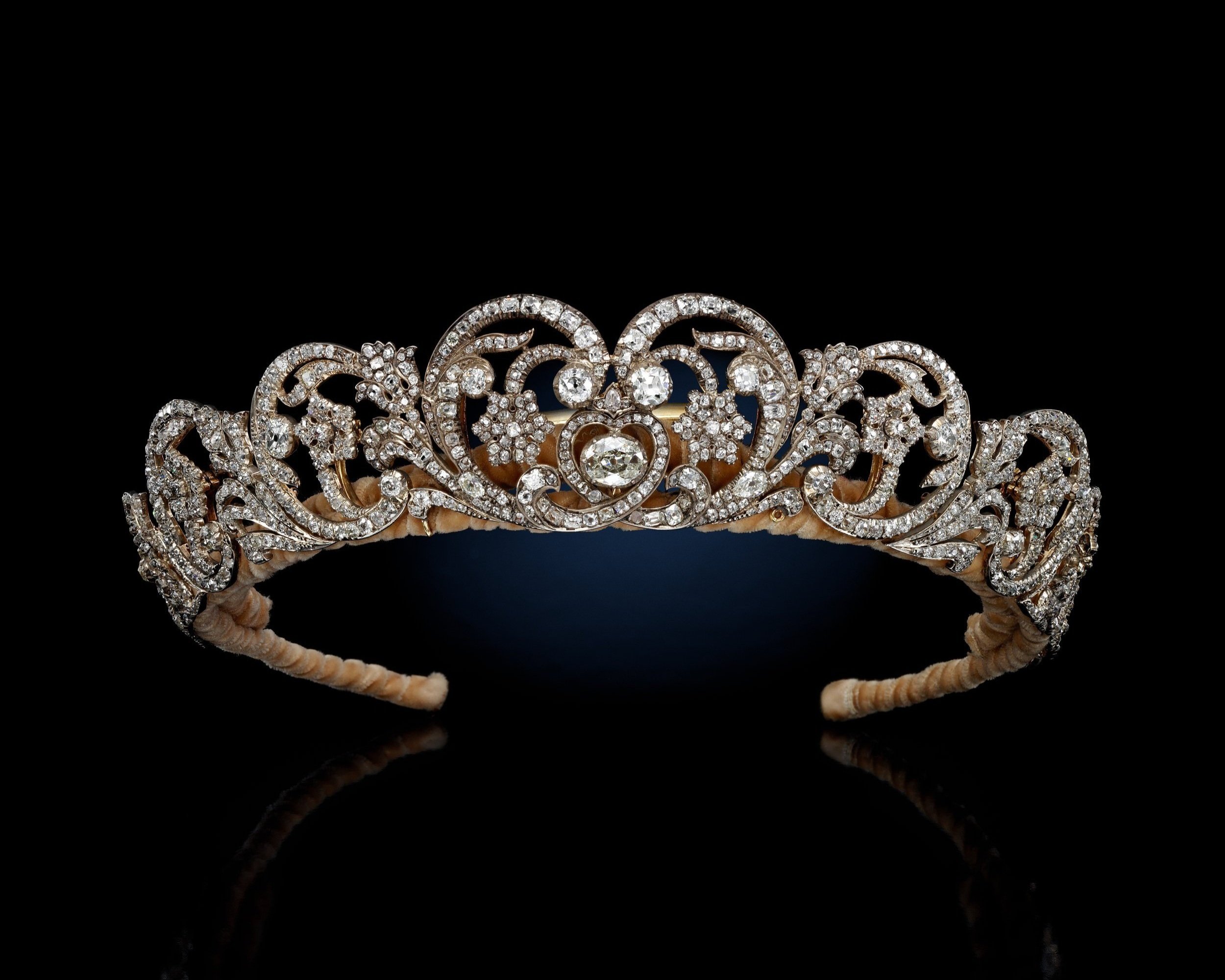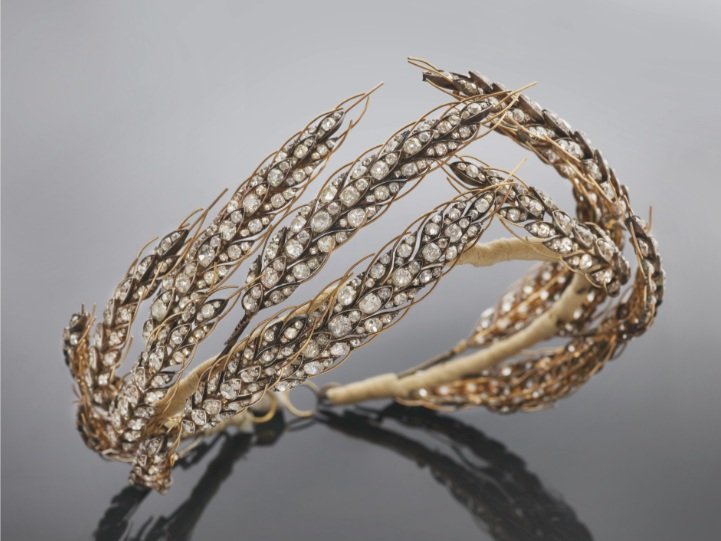Regal and romantic - The tiara, officially the dreamiest of jewels
For a month this summer, 2022, as part of the auction house's Platinum Jubilee celebrations for Her late Majesty, Sotheby's London held a formidable exhibition of fifty tiaras. Entitled Power & Image, most of the pieces were European antique regal and aristocratic ornaments which had been handed down from generation to generation; some were unchanged from their original design, while others show how this most dreamy of jewels could be transformed into a necklace, a necklace and earrings, or modernised to fit with new styles.
Being the most romantic of jewels - it seems the perfect article for Christmas.
Diana's Wedding Heirloom
The most famous, perhaps, of all pieces in the exhibition, was the Spencer Tiara - worn by Lady Diana Spencer at her wedding to Prince Charles in 1981; it is also thought to have been the oldest tiara, reportedly dating back to 1767 However, having been added to over the past 250 years, it was originally more of a small hair ornament than the tiara we know so well today, and as Bruno Barba, head of luxury communications at Sotheby's explains "it is safe to assume that it would have been made by a court jeweller used regularly by the Spencer family for jewellery repairs and new pieces. This would be common to the aristocracy, especially then, to have a go-to trusted jeweller for such requests. A bit like a go-to dressmaker".
The Spencer Tiara, Garrard, mid-1930s, Tiaras exhibition at Sotheby’s, June 2022
There were also several 'brand new' pieces, including a stunning one in the style of a kokoshnik (a traditionally Russian style) by the Duchess of Cambridge's go-to jeweller Kiki McDonough - proving that the tiara is not the relic we might imagine - resigned to a bygone age - but still a beloved and collected piece of jewellery.
Kiki McDonough kokoshnik style tiara
The long history of head ornaments
In the grand history of jewellery, tiaras, as we know them today, are by no means one of the oldest items, although variations have been around ever since primitive peoples wove flowers into their hair and placed garlands on to their heads. With the discovery of copper around 9000 BC, followed by other naturally occurring metals - most importantly gold and silver - these head ornaments became translated into more permanent 'jewels' as symbols of power and wealth, the Ancient Greeks and Romans adorned the heads of statues of their gods with garland like ornaments, as well as being worn at weddings and by those in power. Nevertheless, the tiaras that we see today only really came into prominence in the eighteenth century; although most of the early examples have since been dismantled, the gemstones reset and often resold when the particular style fell out of fashion.
The Empress of Ancient Elegance
A gold, cameo and enamel diadem, Jacques-Ambroise Oliveras, circa 1805, some cameos possibly ancient,Tiaras exhibition at Sotheby’s, June 2022
Napoleon who, with the rise of Neo-Classicism after the excesses of the Rococo-era that helped spur the Revolution, needed a symbol to impress on Europe, his imperial status, after all he had none of the regal heirlooms of his Bourbon predecessors. So it was his empress, Josephine, who became the icon of the era of imperialism.; employing the symbolism from Ancient Greece and Rome to signify his power. And what better than the diamond-set tiara, the 'modern' take on the wreath which had been worn on the heads of emperors, empresses and aristocracy of the ancient world. The tiara then swept from Imperial France to the forefront of fashion within the monarchies and court societies of Europe, and fortunately for all of us who love this sumptuous headdress - has never fully left, many still exist from those heady early days, and are fast becoming collectors' items. Here are a few tiaras recently sold at auction.
Cameo Crazy
At Sotheby's in December of last year, two tiaras set with classical cameos belonging to the empress, came up for sale - both in parures, they were sold as a pair for $795,000. The first tiara was set in gold with blue enamel accents and 25 engraved carnelian cameos depicting the heads of Greco-Roman classical characters. A pair of pendant earrings, a hair comb and a belt brooch featuring Bacchus, the Roman god of wine.
The second was a similar design with gold and blue enamel accents, and included fives oval ancient and 19th century cameos carved from red carnelian, they depicted mythical figures of Zeus, the Medusa, Dionysus, Pan and Gaia. This was also displayed at the Jubilee exhibition.
'Ears of Wheat' Tiara, attributed to Nitot.
In November last year, Christie's Geneva sold another Imperial family tiara dating from 1811. Although this did not belong to Josephine, it was described as belonging to Napoleon's sister Princess Pauline Borghese. The piece, attributed to Napoleon's court jeweller François Regnault Nitot (Chaumet's founder), is set with diamonds in a variety of cuts in gold and silver; the design incorporates one of the most prominent of jewellery themes from the First Empire: épis de blés, ears of wheat which are attributed to Ceres, the Roman goddess of agriculture, fertility and prosperity. Although the dates do not match, Pauline was depicted by Jean-Louis David in his famous coronation painting of Napoleon placing the crown on Josephine's head, in a similar tiara. The tiara can be taken apart to create 18 separate ears of wheat which can be worn in the hair or as brooches. The price realised was CHF 810,000 from an upper estimate of CHF 650,000, and came to auction from the descendants of the princess who died in 1825.
'Ears of Wheat' Tiara, attributed to Nitot.
Princess of Poltimore
In 2006, Christie's sold an important tiara that had belonged to Her Majesty's late sister - Princess Margaret. The enormously tall, Poltimore Tiara was bought by the princess's future husband Anthony Armstrong-Jones, Lord Snowdon, at auction in 1959 for £5,500, it had originally been made by Garrard in 1870 for Lady Poltimore. The design of this spectacular tall tiara features cushion-cut and old-cut diamond clusters alternating with diamond-set scroll motifs typical of the 1870s. Princess Margaret wore it at her wedding, as well as in a photograph of her reclining in a bath, taken by her husband.
Princess Margaret wearing the Poltimore tiara in the bathtub.
A Lover's Knot
Ever since 2015, when the then Duchess of Cambridge first wore the exquisitely beautiful Lover's Knot Tiara, with its 19, mostly pear-shaped, pearls hanging between the lines and clusters of old-cut diamonds - collectors of tiaras have snapped up this most elegant of styles. This tiara, also worn prolifically by the Diana, Princess of Wales, was commissioned for Queen Mary in 1913 and is part of the Royal Collection that belongs to Her Majesty the Queen, which contains the largest collection of tiaras in the world.
The collecting of tiaras - a priceless pastime
Tiaras are very valuable jewels and latterly were created to be transformed into other pieces of jewellery. These are as popular among collectors today as they were with their original owners - due to the wearability of the different pieces.
Tiaras are a beloved jewel by all jewellery collectors, they remind us of the glamour of the past and although many were created in the early decades of the twentieth century - they are a rarity and always very refined. Their provenance is always of interest as people like to recognise the original owners, and photographs or paintings of them being worn often increase their attraction. As Emily Barber, jewellery director of Bonhams UK says "We've sold tiaras which have been worn by members of the same family but to different coronations - something very thrilling to collectors."
The value of tiaras has as much to do with their provenance as their design and diamond carat weight. The more distinguished or aristocratic the person or family for whom it was made, goes a long way in increasing its sale price and the estimate is more often than not greatly exceeded at auction. Buyers in America and Asia particularly like to own tiaras and the Belle Epoque style is much sought after.
Tiaras created by the main jewellery houses such as Boucheron, Chaumet, Garrard and Cartier are extremely admired with the name contributing a great deal to the value, as are the types of stones that are set in the jewel.
Of course tiaras set with emeralds, sapphires and rubies, alongside diamonds, are going to be extremely valuable due to the number of gemstones and their individual worth but aquamarines are spectacular when set with diamonds, in 2019 Christie's Geneva sold a rare aquamarine and diamond Belle Epoque tiara that had been made by Fabergé for Princess Alexandra of Hanover for her wedding - it went for CHF 1,035,000. Tiaras by Fabergé are very rare, most were made for the Russian Royal Family and were broken up by the Bolsheviks after the Revolution.
Traditionally tiaras were only permitted to be worn by married women starting with their wedding day, and at formal occasions such as weddings, white-tie events and state dinners; however Elizabeth Taylor wore the tiara her third husband Mike Todd gave her at the 1957 Oscars and the Queen wore the Girls of Great Britain & Ireland Tiara at the premiere of ‘You Only Live Twice’ at the Odeon, Leicester Square in London in 1967 - although nowadays the Royal Family seem to stick to other opulent jewels than their tiaras.
Where better to finish this piece than with the most expensive tiara ever sold? It was from the collection of Princess Katharina Henckel von Donnersmarck. Although unsigned, it was thought to have been made in 1900 by either Boucheron or Chaumet. This magnificent tiara is set with rose and brilliant cut diamonds in designs of laurel leaf motifs and ribbons, eleven large cushion shaped diamonds as well eleven enormous Colombian emeralds, weighing 500 carats and probably polished in India in 17th or 18th century; the emeralds supposedly belonged to Empress Eugenie of France. All this exciting history led it to achieve an astonishing price of CHF 11.3M when sold in 2011 at Sotheby's Geneva.
Henckel von Donnersmarck tiara
It is far cry from the simple daisy chain placed on a child's head - but, like with all collecting, you've got to start somewhere. And if you're invited to King Charles's Coronation on May 6th - make sure your tiara is sparkling!







